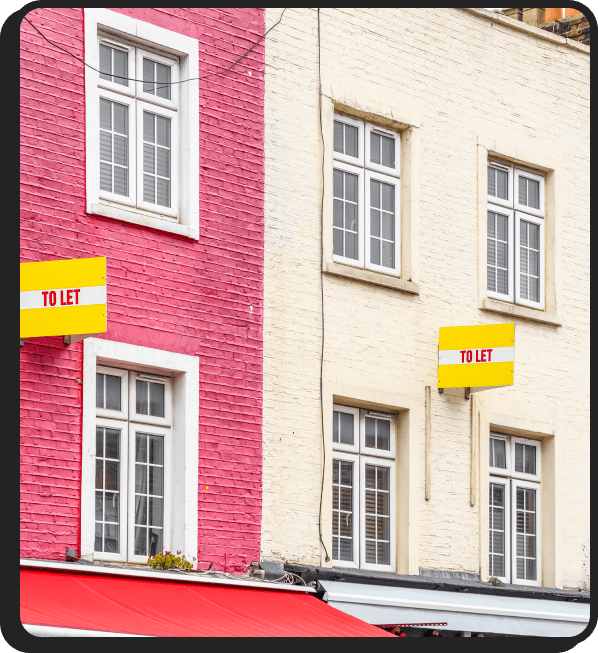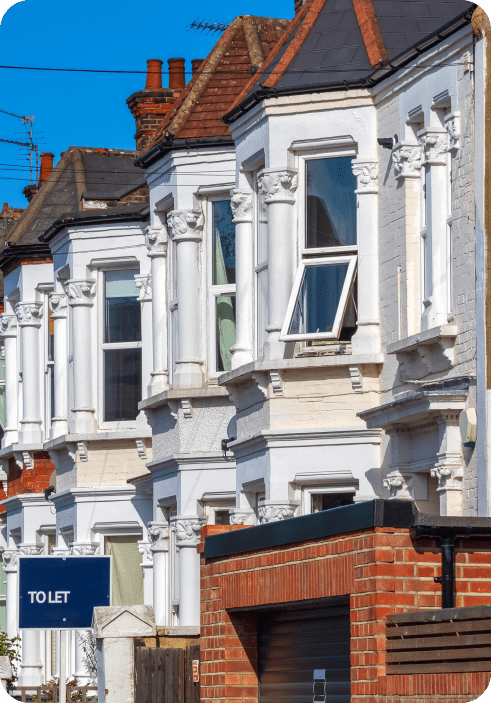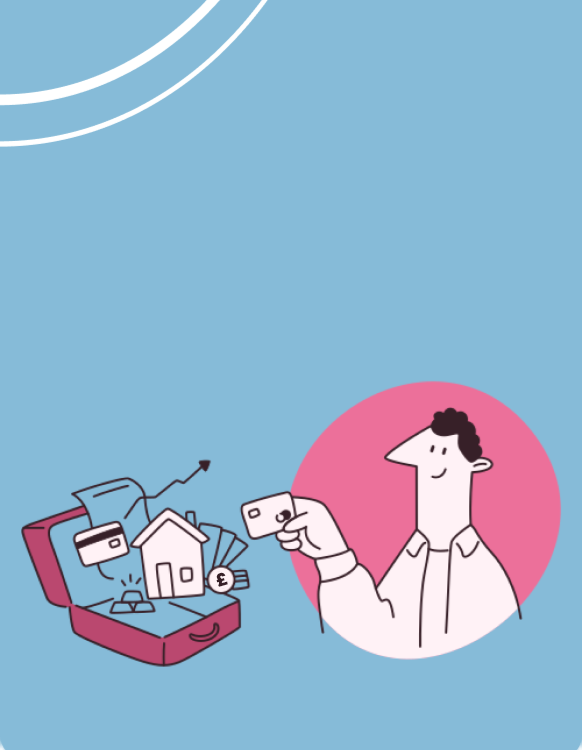
Compare buy to let mortgage deals within minutes!
- Clear assistance for property owners
- Flexible exit strategies
- Book free consultations

What is a Buy to Let mortgage?
A buy-to-let mortgage is designed for people looking to purchase a property with the intention of renting it out rather than living in it themselves. Although it shares some similarities with residential mortgages, there are key differences to note.

1.
When you opt for a buy to let mortgage, you’ll typically need to provide a larger upfront deposit compared to what’s required for a regular residential mortgage. Additionally, it’s common for buy to let mortgage interest rates to be somewhat higher.
2.
This type of mortgage is tailored for those interested in real estate investments where the goal is rental income rather than personal occupancy
How does a buy to let mortgage work?

Put down your deposit
A good place to start with the deposit is around 25% of the property value. There are lenders that will allow a 20% or 15% deposit, but most of the competitive interest rates start with a 25% deposit.

Interest-only payments
Most prospective landlords will use buy to let mortgages as a means to increase their own monthly income. This is achieved by selecting an interest only mortgage, as this keeps monthly payments significantly lower than a repayment mortgage, so as long as the rental income is higher than the mortgage, there is monthly profit.

Pay back the full amount
On an interest only mortgage, you have to select a repayment method. This is the method in which you will tell the bank how you will pay back all of your borrowing. With buy to let interest only, the likely repayment method is to sell the property in the future, as this isn’t your home and you won’t have any personal and emotional connections. If your plan is to keep the property long term, then a simple remortgage to a new lender every few years will allow you to keep the rental income for the long term.

How much will a Buy to let mortgage cost?
The cost for your buy to let mortgage may depend on the following factors:
Loan Term:
A longer-term in buy-to-let mortgages is only a factor if you want to have the mortgage on a repayment basis. As most buy-to-let mortgages are interest only, the monthly amount will stay the same throughout your deal, as you are only paying the interest back, and not reducing the capital borrowing.
Loan Amount:
The amount you can borrow for buy-to-let is largely determined by the value of the property and the achievable rental income for the property. Some lenders will allow you to use your own personal income to boost your borrowing amounts, if the achievable rental income is lower than the lender normally requires.
Deposit:
The size of your deposit (the percentage of the property’s purchase price you contribute) can impact your mortgage costs. A larger deposit may secure you a better interest rate.
Interest Rate:
The interest rate on your buy to let mortgage can be fixed or variable, and they vary from lender to lender. Currently, interest rates in the UK are influenced by the Bank of England’s base rate.
Lender Fees:
Some lenders charge fees for setting up a buy to let mortgage. These fees can vary, so it’s essential to consider them when calculating the total cost.
Type of Interest Rate:
Fixed rate mortgages offer predictability in monthly payments, while variable rate mortgages may have lower initial rates but can change over time.
Property Value and Location:
The cost of the property you’re purchasing and its location can affect your mortgage expenses, including potential rental income.
Market Conditions:
Economic conditions, including changes in the Bank of England’s base rate and market competition, can influence mortgage rates.
Loan Term:
A longer-term in buy-to-let mortgages is only a factor if you want to have the mortgage on a repayment basis. As most buy-to-let mortgages are interest only, the monthly amount will stay the same throughout your deal, as you are only paying the interest back, and not reducing the capital borrowing.
Loan Amount:
The amount you can borrow for buy-to-let is largely determined by the value of the property and the achievable rental income for the property. Some lenders will allow you to use your own personal income to boost your borrowing amounts, if the achievable rental income is lower than the lender normally requires.
Deposit:
The size of your deposit (the percentage of the property’s purchase price you contribute) can impact your mortgage costs. A larger deposit may secure you a better interest rate.
Interest Rate:
The interest rate on your buy to let mortgage can be fixed or variable, and they vary from lender to lender. Currently, interest rates in the UK are influenced by the Bank of England’s base rate.
Lender Fees:
Some lenders charge fees for setting up a buy to let mortgage. These fees can vary, so it’s essential to consider them when calculating the total cost.
Type of Interest Rate:
Fixed rate mortgages offer predictability in monthly payments, while variable rate mortgages may have lower initial rates but can change over time.
Property Value and Location:
The cost of the property you’re purchasing and its location can affect your mortgage expenses, including potential rental income.
Market Conditions:
Economic conditions, including changes in the Bank of England’s base rate and market competition, can influence mortgage rates.
Who is eligible for a Buy to Let mortgage?
Your eligibility for a buy to let mortgage depend on a few distinct factors:
Age
Lenders often have age restrictions for applicants. Typically, you need to be at least in your mid-20s to early 30s, and some lenders may also have upper age limits for when the mortgage term ends. Age criteria can vary between lenders.
Borrowing History
Your credit history is a significant factor in mortgage eligibility. Lenders scrutinise your credit score and borrowing history to assess your risk as a borrower. A favourable credit history is advantageous.
Deposit
A substantial deposit is essential for a buy to let property. Generally, you'll need to provide at least 20-25% of the property's purchase price as a deposit. A larger deposit may lead to better terms and interest rates.
Income
Most lenders will assess the rental income for the assessment of how much you can borrow, however in some cases lenders assess your income to ensure you can comfortably cover mortgage payments, especially if rental income falls short. They may require a minimum income level or evaluate your affordability based on rental income potential.
Home Ownership
Most lenders require prospective landlords to be an owner occupier, which means that they usually require you to already own your home and live in it, before attempting to become a property landlord. However, there are some lenders who will allow a first time buyer to purchase a buy-to-let, but it is usually tricker to get and more expensive with interest rates.
Age
Lenders often have age restrictions for applicants. Typically, you need to be at least in your mid-20s to early 30s, and some lenders may also have upper age limits for when the mortgage term ends. Age criteria can vary between lenders.
Borrowing History
Your credit history is a significant factor in mortgage eligibility. Lenders scrutinise your credit score and borrowing history to assess your risk as a borrower. A favourable credit history is advantageous.
Deposit
A substantial deposit is essential for a buy to let property. Generally, you'll need to provide at least 20-25% of the property's purchase price as a deposit. A larger deposit may lead to better terms and interest rates.
Income
Most lenders will assess the rental income for the assessment of how much you can borrow, however in some cases lenders assess your income to ensure you can comfortably cover mortgage payments, especially if rental income falls short. They may require a minimum income level or evaluate your affordability based on rental income potential.
Home Ownership
Most lenders require prospective landlords to be an owner occupier, which means that they usually require you to already own your home and live in it, before attempting to become a property landlord. However, there are some lenders who will allow a first time buyer to purchase a buy-to-let, but it is usually tricker to get and more expensive with interest rates.
The lady who I spoke to was brilliant. She was lovely and pleasant whilst being professional and fully informative. She was not pushy at all. She certainly had the right attitude and was engaging. If everyone was like her it would be perfect.

Christine Notley
This was the easiest transaction I’ve had in a long time, the customer service was amazing and very helpful and nice to talk with, would highly recommend the company to friends family etc, fantastic customer service. 5 stars from me.

Zoe Mary Hall
Mr Gower was very professional and found the right cover for me. He was polite and engaged in conversation, explained everything easily.

Calum Dobson

Frequently Asked Questions
Buy to let mortgage interest rates tend to be higher than those for standard residential mortgages. This is because they pose a higher risk to lenders due to the investment nature of Buy to let properties. However, the exact rates can vary depending on the lender, your financial situation, and the current market conditions.
Yes, first-time buyers can get Buy to let mortgage, but it can be more challenging. Lenders often require a larger deposit and may impose stricter criteria for first-time landlords. Additionally, having prior property ownership or rental income experience can be beneficial.
Yes, it’s possible to convert your existing residential mortgage into a buy-to-let mortgage, but it’s a process that requires approval from your lender. You’ll need to inform your lender about your intention to rent out the property and request their consent. They may assess your eligibility and potentially adjust your interest rate or terms.
Switching from a residential mortgage to a buy-to-let mortgage is feasible but involves a similar process of notifying your lender and seeking their approval. Keep in mind that buy-to-let mortgages typically come with different terms and interest rates, so you should carefully consider the implications and compare available options before making the switch.
Buy to let mortgage interest rates tend to be higher than those for standard residential mortgages. This is because they pose a higher risk to lenders due to the investment nature of Buy to let properties. However, the exact rates can vary depending on the lender, your financial situation, and the current market conditions.
Yes, first-time buyers can get Buy to let mortgage, but it can be more challenging. Lenders often require a larger deposit and may impose stricter criteria for first-time landlords. Additionally, having prior property ownership or rental income experience can be beneficial.
Yes, it’s possible to convert your existing residential mortgage into a buy-to-let mortgage, but it’s a process that requires approval from your lender. You’ll need to inform your lender about your intention to rent out the property and request their consent. They may assess your eligibility and potentially adjust your interest rate or terms.
Switching from a residential mortgage to a buy-to-let mortgage is feasible but involves a similar process of notifying your lender and seeking their approval. Keep in mind that buy-to-let mortgages typically come with different terms and interest rates, so you should carefully consider the implications and compare available options before making the switch.






